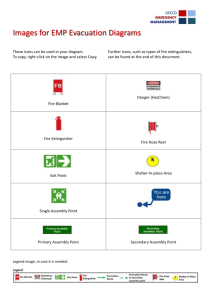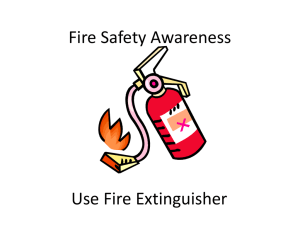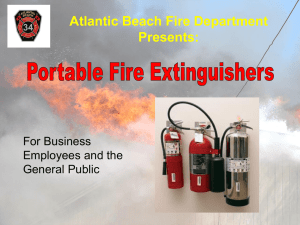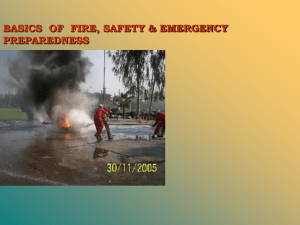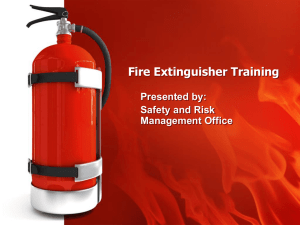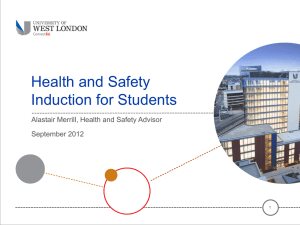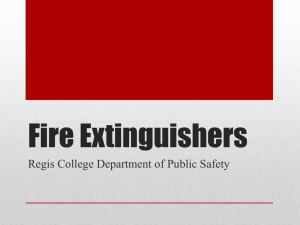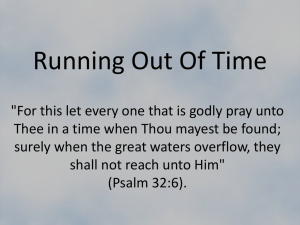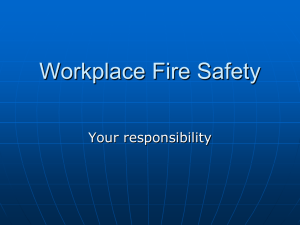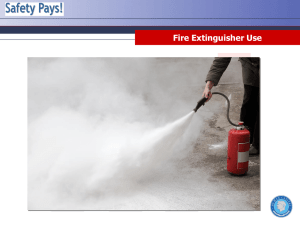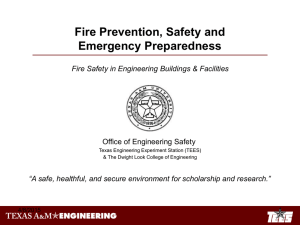Annual Fire Extinguisher Refresher
advertisement
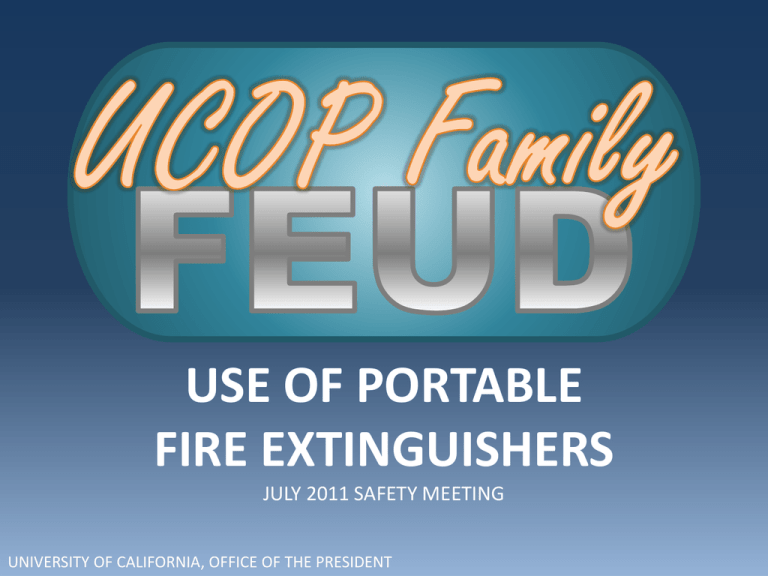
USE OF PORTABLE FIRE EXTINGUISHERS JULY 2011 SAFETY MEETING UNIVERSITY OF CALIFORNIA, OFFICE OF THE PRESIDENT Annual portable fire extinguisher training is required because…? 1 Cal/OSHA regulations 2 You are expected to use a fire extinguisher at work Fire Extinguisher Use Annual Refresher Training for Use of Portable Fire Extinguisher Cal/OSHA Safety Training Requirement Review: 1) General Principles for Fire Extinguisher Use 2) Guidelines on When to Use a Portable Fire Extinguisher Name examples of Type A: Combustible Material fires. Paper 1 Wood 2 Cloth 3 Name examples of Type B: Combustible Material fires. 1 Chemicals 2 Oil 3 Paint 4 Grease Name most common examples of Type C: Energized Electrical Equipment fires. 1 Appliances 2 Electrical Wiring 3 Plugs Major Types of Fires Type A: Combustible Materials Type B: Flammable/Combustible Liquids Type C: Energized Electrical Equipment Name the conditions when use of a fire extinguisher is appropriate. 1 Fire is small and contained 2 Extinguisher rated for type of fire 3 You are properly trained and can confidently operate it effectively 4 Safe Egress When to Use a Fire Extinguisher - Small & Contained - Safe Escape Route Behind You - Extinguisher Rated for Type of Fire You Are Fighting - Trained in Use & Confident You Can Operate it Effectively SLIGHTEST DOUBT – DON’T! Get Out. Close the Door to Slow the Spread of the Fire What are the different types of Fire Extinguishers? 1 Multi-Purpose (Red Color) 2 Pressurized Water (Silver Color) 3 Carbon Dioxide (Red Color with no gauge) Types of Fire Extinguishers Multi-Purpose (Red Color) – Dry Chemical ABC (Ammonium Phosphate) or BC (Potassium Bicarbonate) Pressurized Water (Silver Color) Type A Fire Only Carbon Dioxide (Red Color with No Gauge) Type BC Fire Only When putting out a fire, make sure to aim at… 1 The base of the fire Make sure to aim at the base of the flame! A fire extinguisher that is rated 2A:10 BC means it has a fire fighting capacity equivalent to: 1 2.5 Gallons of Water and 10 Square Feet for a BC Type Fire Fire Extinguisher Capacity Rating For a 2A:10 BC Extinguisher 2A:10 BC – Recommended Capacity for Homes Number in Front of the “A” Equals to Equivalent Number of Units for 1.25 Gallons of Water 2A Equals 2.5 Gallons of Water (2 x 1.25 Gallons = 2.5 Gallons) Number in Front of the “BC” Area in Sq. Ft. that a non-expert is able to extinguish a Class B or Class C Fire 10BC = 10 Square Feet What does the acronym PASS stand for? 1 Pull 2 Aim 3 Squeeze 4 Sweep How to Use a Fire Extinguisher Remember “PASS” Stand 6 to 8 ft away P: A: S: S: Pull the Pin Aim at the Base of the Flame Squeeze the Handle Sweep from Side to Side Step Backwards When Done – Never Turn Your Back Towards an Extinguished Fire! Name actions you should take when you see a fire. 1 Activate a fire alarm system 2 Evacuate the building 3 Call 911 and report the fire incident 4 Use a fire extinguisher to put out fire (if small and contained) You are NOT Required to Use a Fire Extinguisher on a Fire. Your Responsibilities in a Fire Situation: - Recognize a Fire Condition - Activate the Fire Alarm System - Evacuate the Building - Call 9-911 to Report the Fire Condition - Prior to use: Make sure the fire extinguisher is fully charged and the needle is the green area. Remember you are not a Trained Firefighter. YOU SHOULD NEVER PUT YOUR LIFE IN DANGER!
